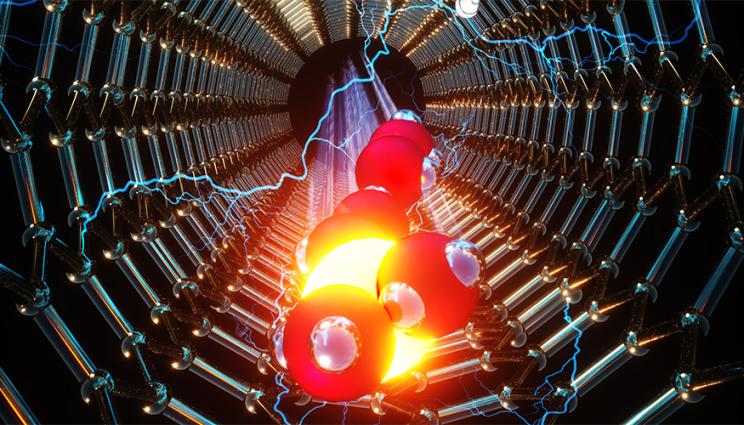| Mar 14, 2023 |
|
(Nanowerk News) When it comes to studying particles in motion, experimentalists have followed a 100-year-old theory that claims the microscopic motion of a particle is determined by random collisions with molecules of the surrounding medium, regardless of the macroscopic forces that drive that motion.
|
Scientists at Lawrence Livermore National Laboratory (LLNL) and the Massachusetts Institute of Technology
have found that this famous fluid dynamics relation, discovered by Walter Nernst and Albert Einstein in the beginning of the 20th century, breaks down completely under strong spatial confinement inside carbon nanotube pores. The research appears in the journal Nature Nanotechnology (“Breakdown of the Nernst–Einstein relation in carbon nanotube porins”).
|
 |
| Artist’s depiction of an ion-water cluster traveling at high speed through a carbon nanotube channel. Formation of ion-water clusters in small diameter carbon nanotubes is responsible for anomalously high electrophoretic mobility of ions inside these channels and ultimately for the strong breakdown of Nernst-Einstein relation in this system. (Image: Ella Maru Studio)
|
|
In 1888, Nernst proposed a universal relation between the mobility of a charged particle and its diffusion coefficient. The microscopic origins of this relation were revealed in 1905 by Einstein, during his annus mirabilis period, culminating with his work on Brownian motion. The NE relation, as it is known, is an essential building block of several important theories of ion transport.
|
|
Confined micro- and nano-environments, such as carbon nanotube porins, can test the NE relation, because confinement can restrict ion mobility, amplify proximity effects, enhance particle–surface interactions and force unusual long-range structuring of liquids, all of which affect the particle motion.
|
|
In the new work, the team tested the validity of the NE relation by investigating potassium (K) ion transport in 0.8-nm-diameter carbon nanotube porins (CNTPs). CNTPs are 10-nm-long segments of lipid-stabilized single-walled CNTs that are inserted into phospholipid membranes to form well-defined transmembrane pores with strong positive ion selectivity.
|
|
“The extreme spatial confinement in these pores hinders the diffusion of K+ ions greatly, reducing the diffusion coefficient by three orders of magnitude relative to its bulk value,” said LLNL scientist Alex Noy, co-lead author of the paper. “Surprisingly, the same confinement has a negligible effect on the electrophoretic mobility, leading to a complete breakdown of the NE relation.”
|
|
Molecular dynamics simulations using all-atomistic polarizable force fields revealed that in the absence of an electric field, the single-file water chain inside the CNTP hindered the diffusion of K+ ions through the CNTP. However, under an applied electric field, the single-file water chain breaks down and forms distinct ion-water clusters, which traverse the CNTs at much higher velocities.
|
|
“These two fundamentally different microscopic mechanisms are ultimately responsible for the breakdown of the NE relation in narrow CNTPs,” said David Blankschtein, co-lead author from MIT.
|


